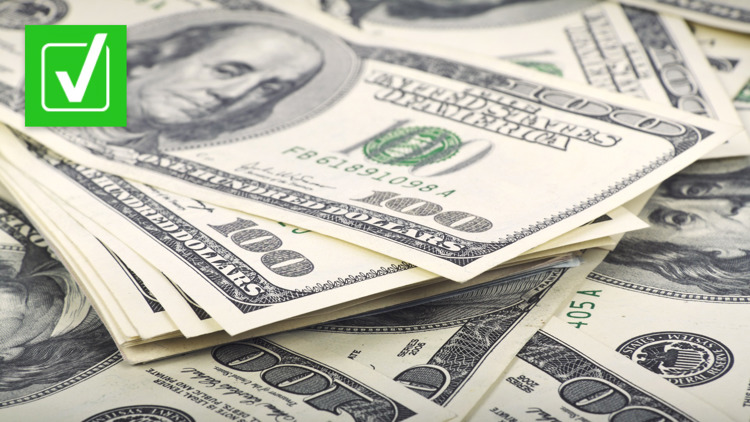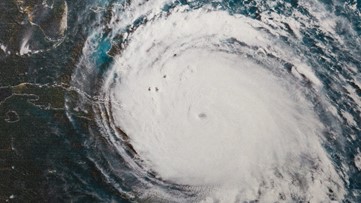Data from the Bureau of Labor Statistics shows that inflation is at its highest rate in 40 years. During his first State of the Union address on March 1, President Joe Biden outlined his administration’s plan to fight rising inflation rates by lowering costs rather than wages and making more goods in America.
Google Trends data shows that people are asking about the cause of high inflation rates and how interest rates and inflation are correlated.
VERIFY is breaking down what you need to know about inflation and answering some commonly asked questions.
THE SOURCES
- Federal Reserve
- Brookings Institution
- Bureau of Labor Statistics
- Tax Foundation
- AARP
- Federal Reserve Bank of Cleveland
- William Hauk, associate professor of economics at the University of South Carolina
- Sarah House, senior economist at Wells Fargo
- Investopedia
- SoFi
FAST FACTS
- Definition of inflation: Inflation is defined as “the increase in the prices of goods and services over time.”
- How inflation is measured: The Federal Reserve evaluates inflation changes by monitoring several price indexes, which measure changes in the price of a group of goods and services.
- Why inflation is so high right now: Consumers began spending more as the U.S. recovered from the COVID-19 pandemic – but supply chain problems persisted, making available inventory more valuable and costly. Wages also increased, leading companies to pass on higher costs to consumers.
WHAT WE FOUND
What is inflation and how is it measured?
Inflation is defined by the Federal Reserve as “the increase in the prices of goods and services over time,” according to the Federal Reserve. It can’t be measured by an increase in the cost of one product or service, or even several.
The Federal Reserve evaluates inflation changes by monitoring several price indexes, which measure changes in the price of a group of goods and services. Its goal is to keep inflation at 2%.
The Consumer Price Index (CPI), produced by the Bureau of Labor Statistics (BLS), is the most widely used measure of inflation, according to the Brookings Institution, a nonprofit public policy organization. The primary CPI is designed to measure price changes that urban consumers – who represent 93% of the U.S. population – face. Urban consumers include professionals, those who are self-employed, the unemployed, retired people and clerical workers, according to the BLS.
According to the Brookings Institution, the CPI is built each month using 80,000 goods and services, from gasoline and food at the grocery store, to cable TV fees and doctor’s visits. The BLS uses the Consumer Expenditures Survey to determine which items should be included and how much weight to assign each one.
“Different prices are weighted according to how important they are to the average consumer. For instance, Americans spend more on chicken than tofu, so changes in the price of chicken have a greater impact on the CPI,” the Brookings Institution explains.
Why is inflation so high right now?
In January 2022, inflation was at 7.5%, the highest rate in 40 years, BLS data show.
William Hauk, an associate professor of economics at the University of South Carolina, wrote in December 2021 that we can attribute rising inflation rates to supply and demand.
Consumers began spending more as the U.S. recovered from the COVID-19 pandemic – but significant supply chain problems persisted. Production costs were higher but the supply of goods was reduced, which led to an uptick in prices.
Wages also increased, as employers offered more money to retain or higher people, Hauk says. Companies often have to pass on these higher costs to consumers.
Wells Fargo Senior Economist Sarah House reported on Feb. 25 that Russia’s invasion of Ukraine has also “added fuel to the current inflation fire.” The price of oil continues to rise, with the conflict fueling concerns about disruptions to the global supply, and agricultural commodities have also jumped in price.
“Unless quickly reversed, the rise in food-related commodities will keep consumers grimacing at the grocery checkout line for months to come,” House said.
How are tax brackets adjusted to account for inflation?
The Internal Revenue Service (IRS) adjusts income tax brackets annually to account for wages and inflation.
Instead of using the more well-known CPI to measure inflation, the IRS uses the chained consumer price index (C-CPI). That’s because of a 2017 law that changed the tax code. C-CPI differs slightly in that it takes longer to rise than CPI, according to AARP.
“The chained CPI takes into account the fact that when prices of some items rise, consumers often substitute other items,” AARP says. “If the price of beef rises, for example, people switch to chicken.”
While federal income brackets change annually, the same can’t be said for state income taxes. The Tax Foundation says 15 states and Washington, D.C., do not automatically adjust for inflation.
How does inflation impact interest rates?
Federal Reserve Chair Jerome Powell serves as the banking system’s public face. He said in early March that he supports a traditional quarter-point increase in the Fed’s benchmark short-term interest rate, rather than the larger increase that some policymakers have proposed, the Associated Press reports. If inflation doesn’t noticeably decline this year, as the Federal Reserve expects it to, the rate hike could be larger.
When inflation rates climb, interest rates typically follow suit to “slow the economy and bring inflation down,” the Federal Reserve Bank of Cleveland explains on its website. When the economy hit a low point in March 2020, during the COVID-19 pandemic, the Fed lowered interest rates to stimulate spending.
Investopedia, a financial website, says lenders also demand higher interest rates as payment for the decrease in the purchasing power of money they are paid in the future.
Inflation rates don’t directly impact mortgage rates, but there can be indirect effects since inflation influences the economy. If inflation rates are rising, mortgage rates tend to do the same and vice versa, SoFi, a personal finance company, explains on its website.
Both Investopedia and SoFi say that the Federal Reserve does not set mortgage rates. Instead, they are tied to 10-year Treasury yields, which are bonds issued by the federal government that mature in a decade.
While the Treasury yield has the most direct impact, a combination of inflation rates, interest rates and the economy as a whole can all play a role in influencing mortgage rates.
VERIFY team members contributed to this reporting.
More from VERIFY: Yes, the IRS adjusts federal income tax brackets every year













